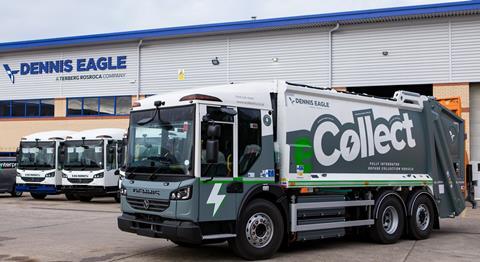
In partnership with RCV manufacturer Dennis Eagle, Freight in the City hosted a webinar on 22 April which took an in-depth view at the electrification of waste and recycling vehicles. MT looks at some of the key themes that emerged in the session.
Chairing the webinar, Freight in the City events editor Hayley Pink introduced the first speaker Andy Graves, product marketing manager at Dennis Eagle, who gave an overview of the manufacturer’s first electric RCV, the eCollect, which is closely modelled on its best-selling 26-tonne 6x2 diesel refuse truck.
Graves said the eCollect’s design was kept as close to the firm’s traditional diesel RCV as possible, so it would feel familiar to the drivers, with the 26-tonne electric RCV sporting the same Terberg split-bin lift and Olympus 19 cubic metre body as its diesel counterpart.
The cab’s interior also saw few changes, Graves added: “There’s a new gear change pad, new programmable switches, a tortoise icon to alert the driver to return to base and a state of charge display rather than a fuel gauge.
“Otherwise, it's just the same as driving one of our traditional vehicles - apart from, of course, the fact that acceleration will certainly pick up much better than on a diesel vehicle.”
Power range was another key consideration since the eCollect is required to make on average two or three daily collection rounds of approximately 10 tonnes of waste and retain enough power to get back to the depot.
Graves said the team’s solution was to install five lightweight lithium battery packs, each with a 60 kilowatt hour capacity, with a total of 300 kilowatt hours, and a 200 kilowatt motor.
He added that data from demonstrator vehicles has shown that the eCollect’s average power consumption is 148 kilowatt hours per day. Pointing to research from one customer’s vehicle in Cheshire, Graves added: “The vehicle did over 94 miles, collected around 13 tonnes of waste -but it still got back to the depot with a 15% state of charge, having used just under 270 kilowatt hours of energy.”
Maintenance and service is also simpler. “We expect the eCollect to be considerably lower in maintenance cost –since there’s no engine oil changes and no particulate filter and it doesn't need changing or inspection or need cleaning.”
With no tailpipe emissions, and noise levels at just 60 DBA, compared to 80dba in the traditional RCV, Graves said the eConnect is growing in popularity and currently in action in nine cities, including Cambridge, Nottingham, Oxford and York.
Next up was Jack Barrett, ULEV grant project officer at Nottingham City Council, who described the council’s experience of the eCollect.
NCC was the first organization to take delivery of the eCollect in September 2020. Barrett said the RCVs performance is impressive.
“Our eCollects do single shifts from 7am to midday. The route is about 30 to 40 miles and the vehicles come back with around 40% charge left.”
He added: “They simply do the job of their diesel equivalent. They perform the same, lift the same, do about 400 to 500 compacted cycles a shift, yet save us about £50 a day on fuel.”
Barrett said drivers love the vehicles after some initial apprehension. “They quickly came to appreciate the benefits of driving electric - the increased torque, reduced noise pollution and improved air quality” adding that some drivers became very reluctant to return to driving the diesel version.
Brian Robinson, commercial vehicle and sustainability consultant at Zemo partnership, talked attendees through the recently completed £32m Low Emission Freight and Logistics Trial in which participating fleets collected data on energy consumption, cost savings and environmental impacts of over 130 trial vehicles, including HGVs, refuse collection vehicles and road sweepers.
Not surprisingly the results showed that battery electric HGVs and vans were the “star performers” Robinson said, cutting greenhouse gas (GHG) emissions by between 50% and 80%.
The trial also assessed the performance of a two retrofitted dual fuel RCV vehicles – one a Euro-5 and the other a Euro-6.
Robinson said that trial results showed little reduction on well-to-wheel GHG emissions if the hydrogen is not from renewable sources. “Whilst tailpipe emissions went down because 15% and 20% less diesel was used, if the hydrogen does not come from a renewable source then it can result in a very high carbon impact wiping out any GHG savings,” he warned.
However 96% of the hydrogen used in the trial was from onsite electrolysis with green tariff electricity, which is 100% renewable.
He also pleaded with organisations still running Euro-5 diesel RCVs to replace them with Euro-6 - if they cannot go straight to electric RCVs - since Euro-6 RCVs deliver 96% to 98% reduction in pollutant emissions.
Zemo Partnership has also recently launched a Renwable Fuels Guide to help operators understand more about reducing fleet carbon emissions with the latest liquid and gaseous fuels.
Attendees then fielded a host of incisive questions for the three speakers including:
• What are the whole life costs of electric RCVs?
• How developed is the charging infrastructure?
• What is the lifespan of electric RCV batteries?
• What are the maintence and testing requirements?
• Is driver training required?
• Are there variants of the eCollect in the pipeline?
• Are trials planned on split body vehicles
• When will electric RCVs become mainstream?
Find the answers to these questions and much more by watching the webinar on-demand, free of charge at freightinthecity.com.














